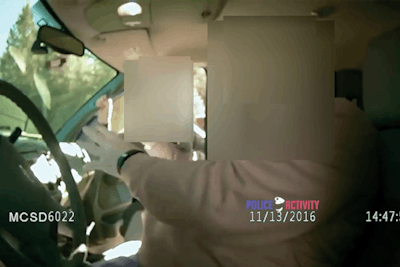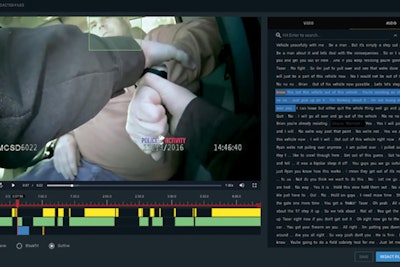 Image showing effect of video redaction using Veritone’s Redact. Veritone says its AI-powered solution is much less labor-intensive than other options and saves agencies money. Usage of the tool is purchased by the running time of the data redacted.
Image showing effect of video redaction using Veritone’s Redact. Veritone says its AI-powered solution is much less labor-intensive than other options and saves agencies money. Usage of the tool is purchased by the running time of the data redacted.
One of the greatest problems faced by law enforcement agencies that field body-worn cameras is how to release the video to the public. It can be tricky because raw video of law enforcement operations often contains images of people and things that should not be in public view, including underage suspects and victims, victims of sex crimes, undercover officers, license plates, and personal data such as addresses on computer displays. The only answer to this problem is to redact the video.
Redaction used to be an incredibly tedious process that involved frame-by-frame editing of the video. Now redaction is partially automated but still a time-consuming task. Redacting one hour of video can take much more than one hour to do. Which means that the labor costs can soar when a law enforcement agency is involved in a controversial use-of-force incident.
During such incidents the action can be captured by the body cameras of multiple officers resulting in hours of evidence from an incident that lasted 10 minutes. The incident can also be captured on a wide variety of other recording systems, including in-vehicle video, surveillance systems, drone cameras, and smartphones. Having to deal with all of those formats can be a nightmare for a law enforcement agency.
And that’s why Veritone developed its Redact solution. Powered by Veritone’s aiWare artificial intelligence technology, Redact is a device agnostic video redaction solution. “Redact can ingest any video and audio streams that do not have proprietary formats of decoding,” says Jon Gacek, head of government, legal, and compliance at Veritone. Gacek adds that Redact can work with data from many of the most popular brands of police video systems and CCTV systems, and even when the video is in a proprietary format, Redact can sometimes make it work.
Gacek says that Redact is not only extremely versatile in its ability to work with different video formats, it is also extremely efficient. “It takes five to 10 hours for a human to redact an hour of video using typical tools, frame by frame. Ours is an hour or less of redaction time for one hour of video,” he explains.
Redact achieves that speed through Veritone’s aiWare, according to Gacek. Veritone says aiWare is an artificial intelligence operating system that “orchestrates a diverse ecosystem of machine learning models to transform audio, video, text, and other data sources into actionable intelligence.” The programming for Redact includes 500 different AI models.
Gacek says Redact came out of a customer request from an agency in the state of Washington. The state has some of the nation’s most progressive public video release laws and police agencies can have a hard time complying with them. The Veritone customer needed to speed up its redaction process. “We built a prototype on the aiWare platform and the customer liked it, so we built the full-blown product,” Gacek adds.
Veritone’s Redact works differently than other law enforcement video redaction tools, according to Gacek. He explains that Redact identifies heads, not faces, so it can target any occurrence of the back or side of that head in the video. It can also identify license plates and computer displays.
“Our product is really simple to use,” Gacek says. He explains that the AI identifies all of the potential images that may need to be redacted. Then “all the human has to do is check or uncheck the ones they want to redact.”
 Veritone’s Redact is an AI-powered video and audio evidence redaction tool. The software automatically identifies heads, computer screens, and license plates. In addition it creates a time-correlated transcript of the audio.
Veritone’s Redact is an AI-powered video and audio evidence redaction tool. The software automatically identifies heads, computer screens, and license plates. In addition it creates a time-correlated transcript of the audio.
Veritone has a history of providing audio clips as proof of placement for radio advertisers, so it’s natural that Redact has powerful audio redaction capabilities. The software creates a time-correlated transcript, and the user can click on a specific word and redact it throughout the file. When the process is complete, the user has a redacted file and an audit log of everything that was done to that file.
Veritone offers a somewhat unusual payment model for Redact. Customers basically pay for the service per hour of data redacted, and there is no upfront cost to acquire the software. “Our starting price is $100 per hour,” Gacek says. He explains that the price for Redact needs to be contrasted with the cost of redaction labor per hour. “Agencies spend a ton of money on having humans do redaction and that is what we are trying to replace,” he adds, estimating that in-house and third-party redaction can cost as much as $250 to $500 per hour of data. By accelerating the redaction, Veritone’s Redact saves on labor costs, Gacek explains.
The $100 per hour of data is also not a hard price. “The more you buy, the lower the cost per hour,” Gacek says. “We sell packages of 10 hours per month and 100 hours per year,” he adds.
Redact is pushed out to users in the cloud, so the software is updated continuously. Gacek says Veritone even provides storage space on its CJIS-compliant Microsoft Azure-based cloud at no additional cost to the user.
Veritone says more than 100 law enforcement agencies have used Redact. The list of customers includes big, small, and even statewide agencies. “Our product is good and this problem is only getting worse,” Gacek says. He adds that many customers contact Veritone about Redact after they have a major incident.
“If there’s an event, we can have them up and running on Redact in just a matter of hours,” Gacek says. “It’s a really simple product to use. We can train somebody to use it in about an hour.”
To aid customers with meeting the demands of open records requests, Veritone has announced a collaboration with GovQA , a leading provider of transparency solutions for government agencies. Under the agreement Redact is being integrated with the GovQA Public Records Management Solution. The combination is expected to help law enforcement agencies expedite requests in accordance with public records laws and save money.
For more information, go to www.veritone.com/applications/redact

